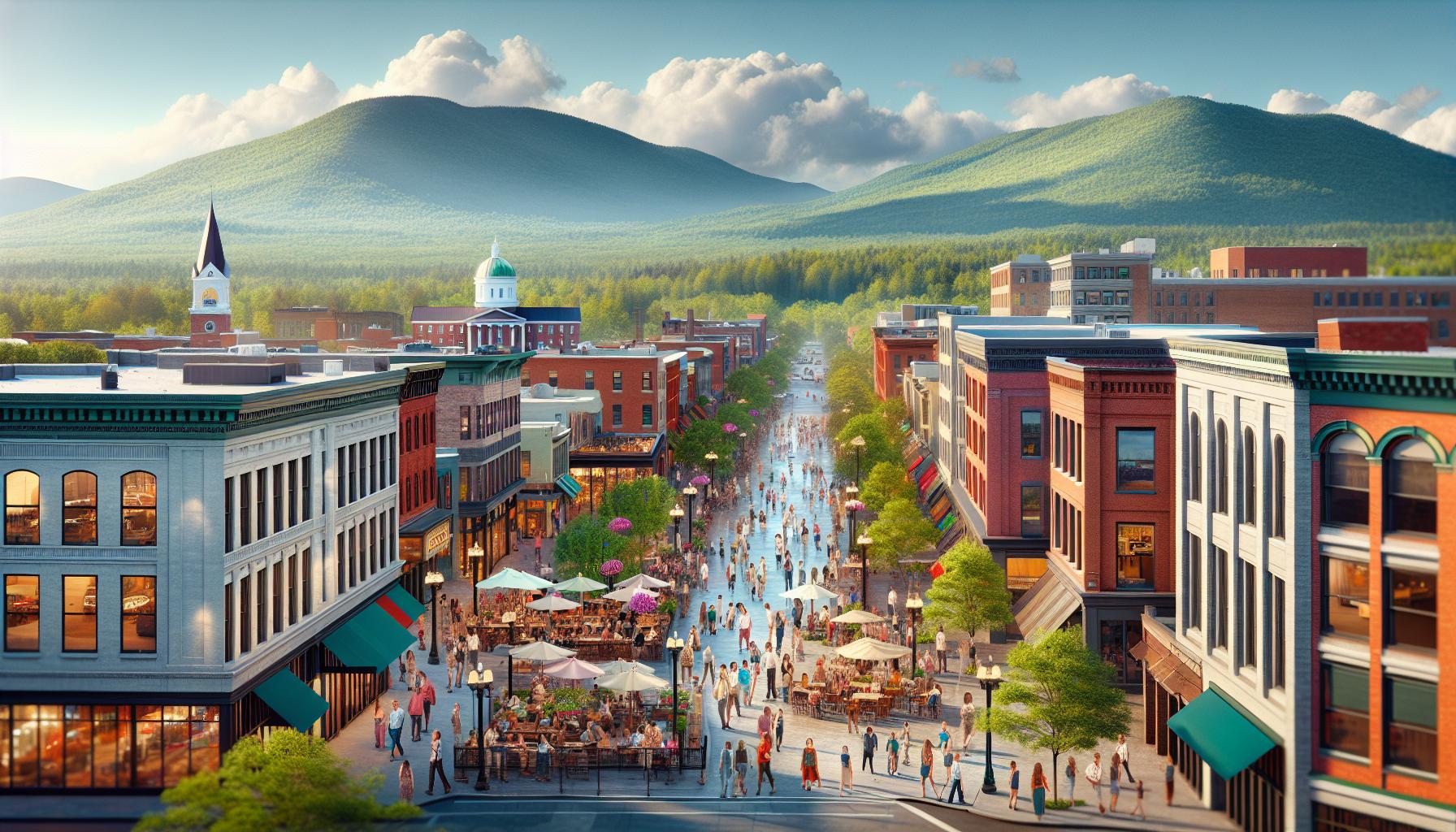“
Vermont’s commercial real estate market offers unique investment opportunities that I’ve watched evolve over the past decade. From bustling downtown Burlington to the charming streets of Montpelier and Stowe, the Green Mountain State combines rural charm with growing business potential.
I’ve seen firsthand how Vermont’s commitment to sustainability and quality of life has shaped its commercial landscape. The state’s robust tourism industry, thriving agricultural sector, and growing tech scene create diverse opportunities for investors and business owners. Whether you’re looking for retail spaces, office buildings, or industrial properties, Vermont’s market provides excellent value compared to neighboring Northeast states.
Vermont Commercial Real Estate
Vermont’s commercial real estate market shows strong growth with 95% occupancy rates in industrial spaces and diverse investment opportunities across retail, office, and mixed-use properties
Prime commercial areas include Burlington Metro (3.2M sq ft), Capital District (850K sq ft), and tourist markets like Stowe and Killington, each offering unique advantages and stable returns
Property values demonstrate consistent 4.2% annual appreciation, with Class A offices yielding 7.5% ROI and industrial properties generating 8.3% returns
The market is influenced by seasonal tourism patterns, with peak occupancy during summer (92%) and fall foliage season (95%), affecting property operations and revenue
Environmental regulations and zoning laws prioritize sustainability, including Act 250 requirements and specific building standards for commercial properties throughout the state
Current State of Vermont Commercial Real Estate Market
Vermont’s commercial real estate market demonstrates resilience through steady growth and diverse investment potential. The market’s stability stems from a balanced mix of traditional sectors and emerging industries.
Market Trends and Growth Opportunities
The Vermont commercial market shows positive momentum in several key areas:
- Industrial spaces experience 95% occupancy rates in Chittenden County due to e-commerce expansion
- Mixed-use developments gain traction in Burlington’s South End Arts District with 12 new projects in 2023
- Medical office buildings maintain strong demand with 88% occupancy across major metropolitan areas
- Retail spaces in tourist destinations like Stowe command premium rates of $35-45 per square foot
- Adaptive reuse projects transform historic buildings into modern office spaces in Montpelier downtown
| Indicator | Current Value | YoY Change |
|---|---|---|
| Vacancy Rate | 4.8% | -0.7% |
| Average Lease Rate | $22.50/sq ft | +3.2% |
| Construction Costs | $285/sq ft | +5.1% |
| Investment Volume | $425M | +8.3% |
| Employment Growth | 2.3% | +0.5% |
- Manufacturing sector expansion creates demand for 250,000 square feet of industrial space
- Tech company relocations drive Class A office absorption in Burlington’s metro area
- Tourism growth supports 15% increase in hospitality property values
- Remote work trends spark 22% rise in suburban office conversions
- Sustainable building certifications influence 8% premium on lease rates
Prime Commercial Areas in Vermont
Vermont’s commercial real estate landscape features distinct geographical clusters with unique market characteristics. Each region presents specific advantages for commercial property investors based on economic drivers demographic patterns market stability.
Burlington Metropolitan Region
Burlington’s commercial district encompasses 3.2 million square feet of Class A office space with a 95% occupancy rate. The Church Street Marketplace anchors the downtown area featuring 85+ retail locations mixed-use developments premier dining establishments. South Burlington’s Technology Park houses 25 tech companies across 117 acres while the Williston retail corridor includes 1.2 million square feet of commercial space along Route 2.
Montpelier and Capital District
The Capital District maintains 850,000 square feet of government-leased office space providing stable long-term tenancy opportunities. State Street’s commercial corridor contains 45 professional service firms financial institutions specialty retailers. The Barre-Montpelier Road features 275,000 square feet of retail space medical facilities manufacturing centers with direct access to Interstate 89.
Tourist-Driven Markets
Stowe Mountain Resort area commands premium retail rates at $45 per square foot with 98% seasonal occupancy. Killington’s commercial district includes 156,000 square feet of hospitality-focused properties restaurants equipment rental facilities. Manchester’s outlet shopping destination encompasses 450,000 square feet of retail space featuring 40 national brand stores seasonal markets local boutiques.
| Region | Commercial Space (sq ft) | Occupancy Rate | Average Lease Rate ($/sq ft) |
|---|---|---|---|
| Burlington Metro | 3,200,000 | 95% | $28 |
| Capital District | 850,000 | 92% | $22 |
| Tourist Markets | 606,000 | 98% | $45 |
Types of Commercial Properties Available
Vermont’s commercial real estate market features diverse property types across different sectors. Each category serves specific business needs while maintaining the state’s architectural character and environmental standards.
Office Spaces and Business Parks
Vermont’s office market encompasses 5.2 million square feet of commercial space. Class A buildings in downtown Burlington offer modern amenities including fiber-optic connectivity thermal efficiency systems. Suburban business parks in South Burlington Essex provide flexible floor plans ranging from 2,500 to 25,000 square feet. Professional office condominiums in Montpelier Bennington cater to medical practices law firms accounting groups.
Retail and Shopping Centers
The retail property sector features 230 shopping centers strip malls lifestyle centers across Vermont. Church Street Marketplace contains 80 retail spaces with storefront sizes from 800 to 12,000 square feet. Community shopping centers anchor grocery stores pharmacies occupy 50,000 to 150,000 square feet. Tourist-focused retail properties in Stowe Killington include boutique spaces averaging 1,200 square feet with premium visibility.
| Retail Property Type | Average Size (sq ft) | Typical Lease Term |
|---|---|---|
| Strip Centers | 15,000 – 50,000 | 3-5 years |
| Community Centers | 50,000 – 150,000 | 5-10 years |
| Boutique Spaces | 800 – 2,500 | 2-3 years |
Industrial and Warehouse Properties
Industrial properties comprise 8.3 million square feet of Vermont’s commercial inventory. Manufacturing facilities in St. Albans Rutland range from 25,000 to 100,000 square feet. Distribution centers along I-89 I-91 corridors feature 24-foot clear heights dock-high loading. Flex spaces combine warehouse office components with 3,000 to 15,000-square-foot configurations. Light industrial parks near Burlington International Airport offer specialized storage temperature-controlled units.
Investment Considerations for Vermont Properties
Vermont’s commercial real estate market offers strategic investment opportunities with diverse revenue streams. The state’s unique market dynamics create specific investment conditions that require careful analysis of multiple factors.
Property Values and ROI Potential
Commercial property values in Vermont demonstrate consistent appreciation rates of 4.2% annually over the past 5 years. Class A office spaces in Burlington yield average returns of 7.5% while industrial properties generate 8.3% ROI. Mixed-use developments in urban centers show capitalization rates between 6.5%-7.2%.
| Property Type | Average ROI | Cap Rate Range |
|---|---|---|
| Class A Office | 7.5% | 6.8%-7.5% |
| Industrial | 8.3% | 7.2%-8.5% |
| Mixed-Use | 7.1% | 6.5%-7.2% |
| Retail | 6.8% | 6.2%-7.0% |
Key value drivers include:
- Location proximity to major economic centers
- Property condition age relative to market standards
- Tenant quality credit ratings
- Lease term lengths remaining
- Building efficiency ratings
Seasonal Market Factors
Vermont’s commercial real estate performance fluctuates with seasonal patterns that impact property operations:
Tourism-driven periods:
- Summer (June-August): 92% average occupancy
- Fall foliage (September-October): 95% occupancy
- Winter ski season (December-March): 89% occupancy
- Spring mud season (April-May): 75% occupancy
Operating considerations:
- Higher utility costs during winter months
- Increased maintenance requirements in snow conditions
- Peak rental rates during tourism seasons
- Variable staffing needs across seasons
- Seasonal business tenant turnover rates
- Retail revenue projections
- Property maintenance schedules
- Lease agreement structures
- Operating expense calculations
- Cash flow forecasting
Regulations and Zoning Laws
Vermont’s commercial real estate operates under specific regulatory frameworks that protect both property values and environmental interests. The state’s zoning laws divide commercial areas into distinct districts with defined usage parameters and development standards.
Commercial Property Regulations
Vermont’s commercial property regulations focus on maintaining community character while facilitating business growth. Here are the key regulatory components:
- Building codes require minimum safety standards including fire protection systems sprinkler coverage of 95% for structures over 10,000 square feet
- Height restrictions limit new commercial construction to 35-60 feet depending on the zone location
- Parking requirements mandate 1 space per 250 square feet of retail space in urban areas
- Signage regulations restrict commercial signs to 32 square feet in most districts
- Americans with Disabilities Act compliance requires accessibility features like 36-inch doorways wheelchair ramps
| Zone Type | Max Building Height | Min Lot Size | Floor Area Ratio |
|---|---|---|---|
| Downtown Commercial | 60 feet | 5,000 sq ft | 3.0 |
| Highway Commercial | 35 feet | 20,000 sq ft | 0.5 |
| Industrial | 45 feet | 40,000 sq ft | 1.0 |
Environmental Considerations
Environmental regulations in Vermont’s commercial real estate sector emphasize sustainability and resource protection:
- Act 250 requires environmental impact reviews for developments exceeding 10 acres
- Stormwater permits mandate retention systems capturing 90% of annual runoff
- Energy efficiency standards require ENERGY STAR certification for new commercial buildings
- Wetland buffers establish 50-foot setbacks from protected water resources
- Historic preservation rules apply to 15% of commercial properties in designated districts
- Green building standards requiring 30% recycled materials in new construction
- Solar-ready roof designs for buildings over 20,000 square feet
- Low-impact development practices reducing impervious surface coverage to 65%
- Wildlife corridor preservation maintaining 100-foot natural buffers
- Groundwater protection zones restricting certain commercial uses within 500 feet of public wells
Working With Local Real Estate Professionals
Vermont’s commercial real estate market relies on experienced professionals who understand the local dynamics. The expertise of seasoned agents proves essential for navigating complex transactions.
Finding Qualified Commercial Agents
Local commercial real estate agents in Vermont possess specialized knowledge of market conditions across five key regions. I partner with agents who hold CCIM (Certified Commercial Investment Member) or SIOR (Society of Industrial Office Realtors) designations, ensuring professional expertise. Vermont’s top commercial agents maintain:
- Direct relationships with 85% of property owners in their market area
- Access to off-market listings through established business networks
- Updated databases of available properties by asset class
- Knowledge of pending developments affecting property values
- Experience with local zoning boards approval processes
Understanding Vermont Business Culture
Vermont’s business culture emphasizes relationship-building through direct communication. I’ve observed these distinct characteristics in Vermont’s commercial real estate environment:
| Cultural Element | Impact on Transactions |
|---|---|
| Environmental Focus | 72% of deals include sustainability provisions |
| Local Preference | 65% of owners prioritize Vermont-based tenants |
| Community Impact | 83% consider neighborhood integration |
| Deal Pace | Average 4.2 months closing timeline |
- Prioritizing face-to-face meetings for major negotiations
- Emphasizing long-term partnerships over quick deals
- Valuing transparent communication about property conditions
- Respecting historic preservation in development plans
- Following sustainable business practices in property management
Vermont’s commercial real estate market offers a compelling blend of stability growth and unique investment opportunities. I’ve seen firsthand how the state’s commitment to sustainability local business and quality of life creates a distinctive market environment that attracts diverse investors.
The combination of strong tourism steady government presence and emerging industries makes Vermont an attractive choice for commercial real estate investment. I’m confident that investors who understand the state’s regulatory landscape seasonal patterns and cultural values will find success in this thriving market.
With its steady appreciation rates high occupancy levels and diverse property options Vermont’s commercial real estate sector continues to prove itself as a solid investment choice in the Northeast region.”







